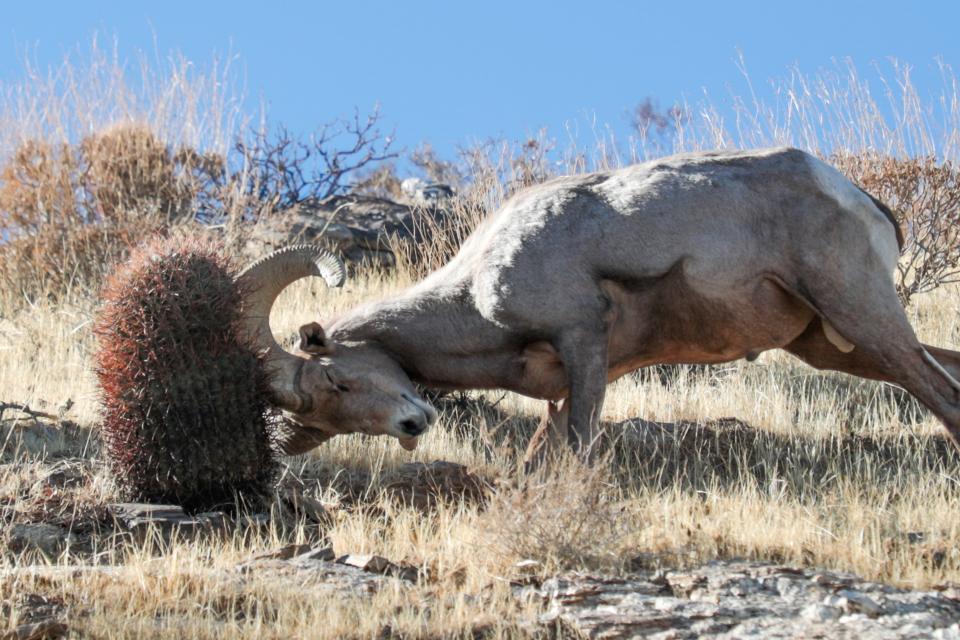Things you can notice in the center of Palm Springs: Tourists and locals stroll through Palm Canyon Drive, rising Marilyn Monroe, hitting a pose and … Bigorn sheep is involved in some retail therapy? Yes, you read this right.
A video that makes circles on social media throughout the week shows two confused looking sheep from Biglern, crossing the Palm Canyon, between the path of East Andreas and the museum road, and taking the shops and slowing the cars around them.
There is a voice in the video that says, “They are simply like” Hmm, trying to go to Brunch “,” providing a cheeky comment on why the two animals may have passed their way down the mountain and in the area of the city center (Psst, Lulu is just a few blocks south). Bigorn sheep usually eats herbs, shrubs and bones, not pancakes, benedict and mimosa eggs.
Another voice says that the person who captures the video can approach the sheep because he is tamed, but the Bigan Institute advises against it.
The video was filmed and shared on Facebook by Jeff Vittun by the Peepas boutique, according to a post that did not immediately answer the desert sun’s request for a comment.
Bighorn sheep is called the home of the Coachela Valley. They live in dry, rocky, desert slopes, canyons and washes from the mountains of San Jackinto and Santa Rosa near Palm Springs to the south to Baja California, Mexico.
The sheep had previously been spotted grazing on the grass at O’Donnell Golf Club, located in the center of Palm Springs, located right next to the rocky, mountain terrain and the cactus next to Clouds Trailhead.
Peninsula Bigor sheep are endangered species
The Bighorn Sheep Ewe and Lamb Desert, part of the northern part of the Santa Rosa Mountains near Palm Desert and Ranch Mirage.
The Bighorn Peninsula sheep are endangered in the United States and have been on March 18, 1998.
The Fish and Wildlife Service in the United States has determined that the Bigorn sheep are in danger of extinction in a significant part of its scope due to disease, predation, habitat loss and human disorders, according to the Bigorn Institute.
In the 1970s, the sheep from the Bigorn Peninsula were estimated at nearly 1,200 in the United States and 4,500-7 800 in Baja California, according to the Biger Institute. Helicopter studies of 2022 show that approximately 800 live in the United States, while Mexico’s studies evaluated California Baja’s population at 2,000-2 500. The institute states that since there are more animals in Mexico than in the US and the Mexican government has set up a Bigler sheep management program, only the US population is included in the endangered list.
In 2019, at least 20 desert sheep from Biglern died in the population of San Gorgonio Mountain due to pneumonia, most likely from domestic sheep or goats. Wildlife specialists also examined other possible causes, including wild cattle pathogens in the West and diseases of a different BIGINN group in the south.
How people influenced the desert begagan sheep

Beron sheep against cactus on the path of southern likcan in Palm Springs, California, on Sunday, December 20, 2020. The sheep were part of a flock of pasture along the path.
Human disturbances are a factor in the decline of the species.
The BIGHORN Institute states that some of the dangers to which are in the area of the city mountain region include car collisions, poisonous plants, high density of predators and parasites.
Between 1991 and 1996 in the North Santa Rosa Mountain, the Bigorn Institute documents five sheep, struck and killed by cars, five killed by the ingestion of poisonous ornamental plants and a strangled fence. During the six -year study, urbanization represents 34% of the death of adults, which makes it the leading cause of death for Biglern in the area.
The urbanization in their habitat also indirectly affects the sheep from Bigorn, changing the use of their habitats, diet and behavior. Changes can also make the type more proposed to parasites and diseases and potentially more vulnerable to predators.
What to do if you see a sheep from Biglern

Pair of Biglern sheep in sand to a national snow monument, a white water canyon
Bigorn sheep sheep are an endangered species and is against the law to cope or harass without appropriate permits, even if it is for the benefit of the sheep, the Bigorn Institute said.
In the event of an emergency of the sheep, call the Bistan Institute at 760-346-7334. If you are unable to reach the institute, call Erin Schaefer with California fish and wildlife at 760-628-4022.
If you notice sheep from Biglern on paths or elsewhere, the BIGINN Institute has several tips:
-
Do not take dogs in sheep with sheep Beigren because they are regarded as dangerous predators and can make them run away from important places to eat and water
-
Minimization of disorders of sheep Bigors. The Institute states that Biglern’s alarming sheep can stress them, leading to an increase in their heart rate and energy costs
-
Avoid using paths in Lamb Bigorn areas during the lamb season (January 1 to June 30)
-
Are not short traces and create new effects
-
Avoid camping or retention to riverside areas, springs or other sources of water vital to the desert wildlife, especially under the conditions of drought
-
Do not leave trail on paths and respect all voluntary and mandatory paths
For more information, visit www.bighorninstitis.org.
Emma Sasi covers fun and health in the Coachela Valley. Reach it at ema.sasic@dasertsun.com or on twitter @ema_sasic.
This article originally appeared on Palm Springs Desert Sun: Endangered Bigger Sheep Make a visit to the center of Palm Springs
